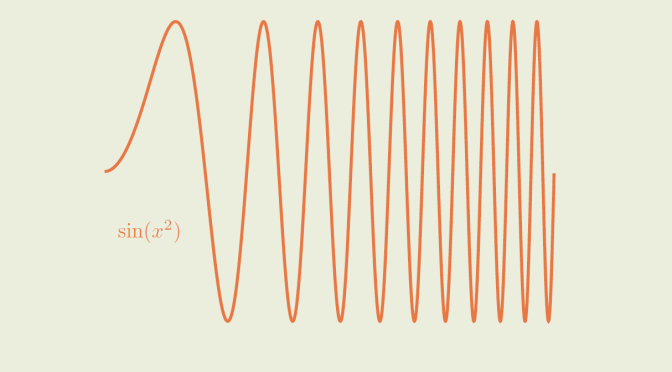We consider real-valued functions.
A real-valued function \(f : I \to \mathbb R\) (where \(I \subseteq\) is an interval) is continuous at \(x_0 \in I\) when: \[(\forall \epsilon > 0) (\exists \delta > 0)(\forall x \in I)(\vert x- x_0 \vert \le \delta \Rightarrow \vert f(x)- f(x_0) \vert \le \epsilon).\] When \(f\) is continuous at all \(x \in I\), we say that \(f\) is continuous on \(I\).
\(f : I \to \mathbb R\) is said to be uniform continuity on \(I\) if \[(\forall \epsilon > 0) (\exists \delta > 0)(\forall x,y \in I)(\vert x- y \vert \le \delta \Rightarrow \vert f(x)- f(y) \vert \le \epsilon).\]
Obviously, a function which is uniform continuous on \(I\) is continuous on \(I\). Is the converse true? The answer is negative.
An (unbounded) continuous function which is not uniform continuous
The map \[
\begin{array}{l|rcl}
f : & \mathbb R & \longrightarrow & \mathbb R \\
& x & \longmapsto & x^2 \end{array}\] is continuous. Let’s prove that it is not uniform continuous. For \(0 < x < y\) we have
\[\vert f(x)-f(y) \vert = y^2-x^2 = (y-x)(y+x) \ge 2x (y-x)\] Hence for \(y-x= \delta >0\) and \(x = \frac{1}{\delta}\) we get
\[\vert f(x) -f(y) \vert \ge 2x (y-x) =2 > 1\] which means that the definition of uniform continuity is not fulfilled for \(\epsilon = 1\).
For this example, the function is unbounded as \(\lim\limits_{x \to \infty} x^2 = \infty\).
A bounded continuous function which is not uniform continuous
Let’s consider \[
\begin{array}{l|rcl}
g : & \mathbb R & \longrightarrow & \mathbb R \\
& x & \longmapsto & \sin(x^2) \end{array}\] \(g\) is continuous on \(\mathbb R\) as it is the function composition of two continuous functions. For \(k \in \mathbb N\), we denote \(x_k=\sqrt{2 k \pi}\) and \(y_k=\sqrt{2 k \pi + \frac{\pi}{2}}\). We have
\[g(y_k)-g(x_k)= \sin(2 k \pi+\frac{\pi}{2}) – \sin(2 k \pi)=1\] and
\[\begin{aligned}
0 \le y_k-x_k &= \sqrt{2 k \pi + \frac{\pi}{2}}-\sqrt{2 k \pi}\\
&= \frac{\pi}{2} \frac{1}{\sqrt{2 k \pi + \frac{\pi}{2}}+\sqrt{2 k \pi}}\\
&\le \frac{\pi}{4}\frac{1}{\sqrt{2 k \pi}}
\end{aligned}\] The uniform continuity definition is not fulfilled for \(\epsilon=1\) because \(\lim\limits_{k \to \infty} \frac{\pi}{4}\frac{1}{\sqrt{2 k \pi}}=0\). Hence \(\lim\limits_{k \to \infty} y_k-x_k=0\) while \(g(y_k)-g(x_k)=1\) for all \(k \in \mathbb N\).
To conclude, let’s recall that according to Heine-Cantor theorem, a function that is continuous on a closed interval \(I\) is also uniform continuous. So, it is not possible to find an example as in previous paragraph for a function defined on a closed interval \(I\).
The following exercise is left to the reader interested in uniform continuity.
Exercise: A real-valued function defined and uniform continuous on \([0,1)\) is bounded and has a limit at \(1\). Find counterexamples proving that both conclusions might be wrong for a continuous function.

